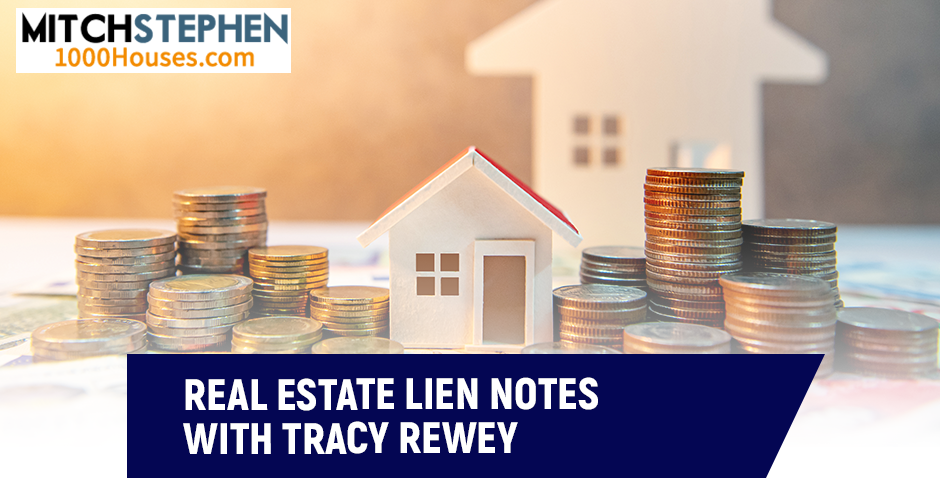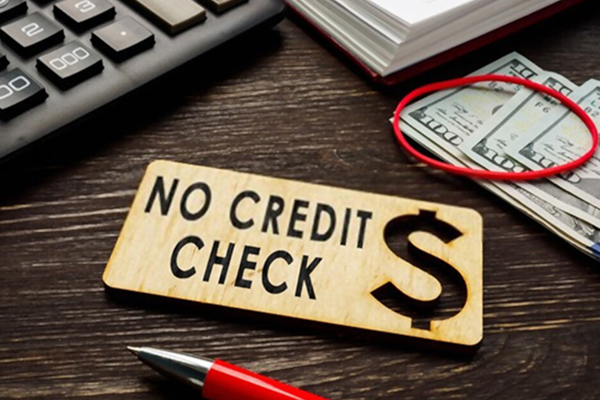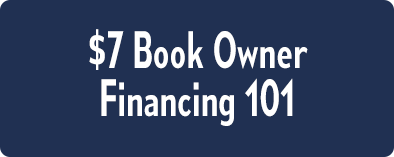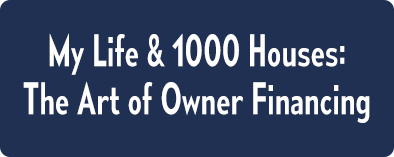PODCAST
Real Estate Lien Notes With Tracy Rewey


Mitch Stephen chats with
Tracy Rewey
Episode 512: Real Estate Lien Notes With Tracy Rewey

People don’t realize how much money is out there moving around the main street and not Wall Street. One of the best ways to earn that money is to invest in real estate lien notes. Mitch Stephen’s guest in this episode is Tracy Rewey, the Cofounder of NoteInvestor.com. Tracy has handled millions of dollars in owner-financed real estate notes and alternative cash flow purchases since 1988. Join Mitch and Tracy as they talk about seller financing and what you need to do to succeed in selling lien notes.
—
Watch the episode here
I have Tracy Rewey here and we are going to be talking about real estate lien notes, the ins and outs, how to create, buy and sell them, how to even sell a piece of one called a partial. How are you doing, Tracy?
I’m doing well, Mitch. It’s great to be back on the show. I know we have a shared love for seller and trading financing. It’s always fun being on your show and talking notes.
I’ve started a love affair with note cashflow a long time ago and it’s never ended. In fact, my love has grown deeper and deeper.
I did a presentation for our Wize Women Expo. It’s called My 30-Year Romance with Creative Financing. We obviously shared the same love and passion.
As people out there may or may not know, I specialize in creating seller finance notes, which is buying a house for $0.50 on a dollar, selling it for $0.100 on a dollar with a 10% down payment and carrying the 90% balance for 30 years fixed at 10%. That’s what I did. I don’t intend to sell notes anymore. Although, I do, when I want to come up with $1 million or whatever to buy or to put on as a down payment for a storage facility or something.
I don’t liquidate notes until I do. What did I do? I’m moving into some other cashflow stream, which is forever because notes will expire eventually. They all do. I try to move my money over into something forever. I specialize in self-storage units and boat storage is on dry land and all that stuff. That’s my forever strategy play. I also have sold partials because for lots of reasons. I wish I had sold a partial on every note I ever did. I wish I had held two years of every note I ever owned. I would have been 2,500 times owed two years’ worth of payments still but you live and learn.
It’s that 2020 hindsight. Believe it or not, there’s $23.5 billion with a B of that seller finance paper created like you’re doing every year. People don’t realize, “Seller financing is small,” but it’s a sizeable chunk of the market. There are maybe 20% of people who understand how to do it the right way as you create it as a strategy. The other 80% are people who sold the property and took back a note. It’s not something they do normally. It’s not always exactly the way a note buyer would love to see it. We come in after the fact, where the companies that like to come in and buy the notes from people who created them as you do.
It’s important to say if you’re a consistent manufacturer of real estate lien notes and creator of them then you need to apply by the certain state and Federal Laws so that your note has more weight. It’s less cumbersome for someone like Tracy to buy so that you can get the highest dollar for your asset or that personal piece of property that you have called a real estate lien note.
Let’s talk about that. I bet you love it when you see someone like me that walks through the door. I’m all Dodd-Frank compliant. I’ve done my state statutes, the cooling-off periods, the notifications and all that stuff, and then I have my property with a note servicing company. There’s no jerking around of whether I got payments or I didn’t get payments. I have this great history of the note that’s verifiable. How important is that to the price of a note?
Seller financing is small, but it's a sizeable chunk of the market. Share on XIt’s very important. We love to see that. We also know that somebody’s smart enough they’re going to ask for top dollar pricing. It comes with a good and a bad because somebody didn’t know to do that. Sometimes I fix that note and buy it for a better price but either way we need to circle around on that. It’s a very important fact that you mentioned there. When we look at notes, we look at three P’s. We look at the People, the Property and the Paperwork. The people, can they afford it?
A piece of that Dodd-Frank compliance, as you mentioned, is the ability to repay. Can they afford to make the payment? We don’t want to set them up in a transaction they’re not going to be able to make the payment. We want to set them up so they can pay it and own that house free and clear someday. We look at the people and their creditworthiness. We look at the property to see if it’s got a good loan to value. The buyers have some equity, they put some money down. That it’s resalable and livable. We look at the paperwork. I’ve been doing this since 1988. The paperwork compliance has gotten tougher.
2014, as you mentioned, Dodd-Frank, applied some rules. They did make exemptions for seller financing. If you did 1 to 3 in a 12-month period but people who are doing regularly definitely need to pay attention to Dodd-Frank and also the SAFE Act, in their own state. Don’t get scared. When this first came out, everybody’s like, “The sky is falling. We’re never going to be able to do notes.” It’s like, “I did too. I admit it.”
For a while, I’m like, “I’ll buy notes from before 2014.” That was great until inventory started to dry up. I’m with you. We all did it but there is a way to do that. Use an MLO, a Mortgage Loan Originator that understands seller financing, Dodd-Frank and SAFE Act compliance. They’ll paperwork it. Paper it all up. They’ll do the backtesting. Now, you have a transaction that is compliant and it’s easier to sell on the secondary market. You get a better price and have fewer claims that the buyer can make because something wasn’t done right during the closing.
I was afraid too. Everyone was packing it and they were, “I’m going to rent houses.” All my seller finance friends say, “I’m going to go back to being a landlord.” I started too. I would go that way and think, “I hate being a landlord too. There’s too much money in this. I need to figure it out.” I decided that I was going to get nose-to-nose with all that regulation, hire an attorney and figure out, “What the hell do these 2,500 pages say? What do I have to do to comply?” Let’s start there.
It took a while to get through it. At the end of the day, I had to hire an armalow and do what they said, pick one that you trust or one that was highly recommended, pay the fee. My houses used to be zero closing costs. You could meet me at 8:00 in the morning. You could go get your money at noon while we were doing the papers.
You could come sign at 4:00 and could be moving in at 5:00 for no closing costs. Just your down payment, approval and that was it. Guess where all the expense for that regulation gets pushed right to the buyer, the person they were trying to protect, it always happens. Now it’s about $1,700 to closing costs. You can’t get in a house for 10 or 15 days. It takes time for all this paperwork to go through.
We adapt, carry on and find new ways of doing things. At the end of the day, we wish it was the other way but we’ve all found ways to make it work. We can pass those costs onto the buyer or the borrower so it doesn’t affect our profitability. It requires them to bring a little more to closing.
I hate to say this because it pains me. I started looking at people harder and my default rate fell drastically. I’m down to a 1% default rate, even through COVID it didn’t change. If you’re going to look at these people, they’re making you do this stuff. Look at them hard. You’re already in their background and their credit. What standard do we want to set? We ended up finding much better buyers. I hate to admit it but it did do something for us. Who’s your typical note seller? What does your typical note look like?
We work with two types of sellers. Some sellers have only created one note in their whole life and they probably won’t create another note. They look like all shapes and forms. People who are manufacturing, creating notes as part of their strategy for buying and selling real estate ideally have 10% down, 9.5% interest rate and a 30-year term. They’ve got a nice papered-up file. They verified the borrower has the ability to repay.

Real Estate Lien Notes: It’s better to see somebody with no credit than bad credit.
That would be the ideal note but we buy notes with 0% interest rates. We have to discount them down. If we want a 10% yield, we’re going to have to discount those down, do a partial or do some other creative strategy. Notes come in all shapes and sizes. Our standard one is like the one you mentioned at the top of the show, 10% down. Sometimes they have no credit. That’s very common. I’d rather see somebody with no credit than bad credit. If they have bad credit, we look to see what life circumstances have happened that might have contributed to that. If it’s habitual or a one-off life event that they’ve recovered from.
When I’m trying to find a buyer for my seller financed house, I’m looking for a good person that had something bad and they’ve recovered but the credit bureau is not forgiving them. A lot of times, I don’t care who you are. I’ve had good credit my whole life but don’t think I’m so naive to think that it couldn’t happen to me. It could happen to me. It can happen to all of us. The cool thing is Tracy and Mitch Stephen are not box checkers. We can go, inquire, do some investigation, feel around and find out, “Is there anything salvageable about this applicant? What are the redeeming factors?”
We can make decisions based on the information that we find and that’s all we ever do. We live or die by that reconnaissance. You live or die by it in the note business, for sure. I live and die by the person that I make a note with. It’s very important to do that. Many people take the first person that comes along that has down payment or take the person with the biggest down payment, which is not necessarily the best guy for your business.
You need to perform some due diligence on them. We’re all in this for-profit but we also are able to do good. We can provide people with affordable homeownership and a second chance. If you’ve done this well, you’ll find that in 7 to 10 years that people will go out, refinance, pay off and you do it all over again. When you get to send them either the paid and full release of deed of trust or if you’re in a contract for deed, state the deed, that’s a very happy day. I’m sure you’ve had many people thank you over the years for providing that ability to own their own home.
While we’re on the subject, most of the people that I sell notes to they’re inherently flawed. They can’t seem to make twelve months’ worth of car payments on time. There’s always one month straggling or something. That’s why I took balloons out of my notes because they’re flawed when I met them. It’s because I put a balloon in the payment doesn’t mean they’re going to un-flaw themselves. They’re going to be who they are.
I started making 30-year straight mortgages because I got tired of having to make a choice to either take the person’s house away from them because they’re not meeting the balloon requirements and paying me off or letting them see that they can walk all over the contract that they signed. It was not a good thing either way. I started going to 30-year mortgages. What’s the argument in 30-year mortgages? A lot of note buyers like shorter notes. They’ll say your notes are worth more if it’s shorter. I have found that there are people out there that appreciate 30-year notes too. They last longer and hold their balance longer.
I like all notes. You have to find the right way to buy each note, the time value of money when you put it into one of my favorite financial tools, a financial calculator like HP 12C. When you’re discounting it down, if somebody was smart enough to write it at 30-year, 9% is great. Somebody wrote it at 3% or 4% and now we’re wanting 9%. The longer that stretches out the less it is worth than the present value dollar.
From that perspective, that can be problematic. If you wrote them right with a good interest rate, long-term is wonderful. We’ll buy shorter or long-term. We have to find the right price based on investment to value, how much we’re investing compared to what the property’s worth and what the remaining term is on the notes including the interest.
We figure those two things and come back with the price. That’s why we transitioned a lot to partials. If somebody did a long-term 3% or 4% interest note then perhaps we’ll buy the next 5 or 10 years. They can continue to have some of that interest work on the residual side. We can buy some more payments if the borrower buyer hasn’t paid off by then.
The key is marketing and deal sourcing. That's true of any business; whoever controls the deal flow controls the outcome. Share on XLet’s explain a partial. Let’s say I have 25 years left on a 30-year note. Did you guys know that you could sell in the next five years? Tracy could collect the next five years’ worth of payments but then at the end of that five years, the note reverts back to you. That’s what’s called a partial. I would also like to talk about people who say, “Who the hell was going to pay 9% or 10% on a mortgage? Who does that?”
Let me tell you, it’s like a tote your note car loan. The person that’s there is not interested in the price and the rate. They want to know, “Can I come up with enough down payment to satisfy the seller? Can I afford the payments?” It’s the same thing in the house business. Let me tell you how we overcome it. I have a rent formula. If I can figure out the rents in the neighborhood, I back into the rents to find out the sales price of my house.
After they gave me a 10% or a better down payment, their Principal, Interest, Taxes, Insurance and Servicing, PITS, payment is about what they’re paying for rent, a little bit less or more or dead on but it’s right there. The question is, this person is going to be a renter for the rest of their life if they don’t find an owner-financier like myself or someone like us, Tracy. “Are they going to be a renter the rest of their life? Are they going to go ahead and move into a house with the same monthly payment who gives a damn that the interest rates are 10%?”
It shouldn’t because they are in a losing position now. They’re renters. How much equity that you get as a renter? Zero. How much appreciation do you get as a renter? Zero. How many tax write-offs do you get as a renter? Zero. What are the rents going to be in ten years from now? They’re not going to be the same as my mortgage payment. Mortgage payments are going to stay the same. It might be 10% but it’s not going up.
In fifteen years, what will the rent be? What will the rent be in 20 years, 25 years? I have realtors accuse me, not all the time because I run away from them most of the time. When they trapped me in a house, they say, “You’re ripping these people off at 10%.” I’m going, “The landlord’s ripping them off. He’s not giving them anything. He’s charging the same as me this year. He’ll be charging more than me next year.”
Real estate agents charge 6% upfront. The notes we see don’t have any prepayment penalties and that pretty much went away over the years. When people qualify for those lower rates, they can always go out and refinance and pay off without a prepayment penalty. This gives them that vehicle, avenue, path until they are able to get the traditional financing. They get to own and get to live in it. I have people also claim that it’s very risky to owner finance for people or to have owner finance notes. These are the same people that are landlords. They’ll let somebody move in for a $1,000 deposit. These people are renters.
Renters do not take care of homes as owners do. Owners take care of it. They maintain it, pay taxes, insurance and maintenance. Renters call you at 2:00 AM after they get home from the bar and walk themselves out or in the morning when their three-year-old flushes their favorite stuffed animal down the toilet. Owners don’t call the bank when those things happen. I would rather be a lienlord than a landlord. We get a down payment and people make their payments. You got to make sure that they can afford it. It’s not much more than what it would be to rent.
I liked that. That was one of the deciding factors for me to move from being a landlord and then go into lienlord. I like that word lienlord. I never heard that before. Did you coin that?
I would love to say I made it up but I heard it and I borrowed it because it’s a good one.
Who said it?

Real Estate Lien Notes: Renters don’t take care of homes as homeowners do.
I don’t know. I heard it somewhere. I wish I could say I made it up but no.
That’s what I noticed. I was a landlord. On my goal sheet, I was getting these houses. I knew how much I owed and how much the rent was. I had this number that I was supposed to collect. In the end, it was supposed to be my money but it always turned out to be way less, if any, at all, in that number. I was a landlord with 25 houses for about two years. I figured out I wasn’t making any money. I was getting some appreciation but I was banking my own expenses. I started looking into owner financing. The cool thing about owner financing was when the payment came in from my payer, it was my money.
There was no reason for it to go out. If the air conditioner broke, it wasn’t my air conditioner. If the roof leaked, it wasn’t my roof. The only reason I would ever have to spend any of that money was if they didn’t pay it all. I had to hire an attorney to get them out but then I was going to find another person with another down payment and make it all up and more.
Probably I’ll sell the house for a bigger sales price than originally because houses, in general, build up over the years in value. I learned the dynamic. Renters move in, tear your house down and move out. Owner finance buyers, move in, fix your house up because it’s their house now. They stay for years and years.
Mine only get paid off like 98% of the time when I’m getting a payoff, they didn’t refinance because of that flaw that I’m talking about. What they did was they needed to move, wanted to move to a different house or got transferred. They got a realtor and list the house. That’s when I’m getting the call for the payoff is they sold the house to a new loan buyer and got to pay me off.
We call those a happy payoff dance at our house. We do a happy payoff dance it’s because we buy notes at a discount. Whenever there’s a payoff that makes our return go up because we bought a discount expecting a certain yield over 20, 30 years. Now we’re getting all that money back sooner. We like early payoffs.
What do you want to say to people out there that are looking for something to do and they’re considering the note buying a business? What do you say to the newbie out there that’s looking for a way to quit the job? He’s trying to get an income to surpass what he’s getting paid by his boss for the job. What do you say to them?
Notes can be one avenue. Real estate in general is an amazing avenue. There are multiple ways that you can participate. You have to figure out, “Do you have time to bring to the table? Do you have money to bring the table or both?” If you have someone who has time but not a lot of money then you have to start thinking about referring notes. You got to be sourcing deals. In the real estate world, you might start out as a wholesaler. You find the deals and bring into somebody that has the money. You earn a fee for that.
In the note investing world, if you found a note and you brought it to me and you couldn’t buy it, we could buy it and pay you a referral fee. You can wholesale a note like you can wholesale real estate. You’re spending your time sourcing deals. There are lots of note investors out there, not just myself, that would love for you to bring me a deal and we’ll pay a referral fee.
The art of that whole what she said was that you could be getting paid to learn a craft. The guy who knows how to source the most deals is the big winner. The guy that’s sourcing them because he owns the world. Pretty soon he won’t need to take fees. They will go on. I know you don’t want to hear that. I don’t want to hear that too but the wholesalers and the note brokers grow up.
People don’t realize how much money is out there moving around the main street and not Wall Street. Share on XThat’s the next phase that you would like to start keeping a piece of some of the notes. You could buy a full and sell a partial. If there are 30 years left, you could sell off say 25 years for the same price you bought 30 years and keep 5 years on the back end. You could even do that if you structure it right, without coming up with the money to buy the 30 years and then sell the 25 years. You can structure that so it all happens at once. That’s where partials are beautiful. Maybe you can start selling off 20 years and keeping 10 years on the back end. Maybe you can sell off 15 years and keep 15 years on the back end but that’s future income. You have to think about money now and money later.
I’m not deep in your game but my instinct is if I want to go into your business, I am going to start learning how to source notes. As soon as I’m confident, I can source plenty of notes then I’m going to go try to source the money guy. I’m going to become partners with them now. I’ll find them. You fund them. We’ll form an LLC. Half of something is better than 100% of 0.
I would agree with you. You get to the point where you start buying notes. We love to see people buy notes in their self-directed retirement account because they are a more passive investment than fixing and flipping real estate. They make a great investment. There’s no depreciation when you buy real estate notes. We don’t get as note investors depreciation or appreciation like a real estate investor does.
There are some tax advantages to buying and selling real estate outside your retirement account. Whereas there are great advantages to having that interest income, note income either tax-free or tax-deferred in a self-direct retirement account. That might be the next place somebody moves into if they’re in the note investing world is to buy a whole note because they want that long-term interest income.
If they don’t have the funds to do that, they’re doing what we talked about. They’re finding the deals sourcing them, referring them for a fee, working themselves into a certain number of deals. Sometimes you can even sell a deal, make some money upfront and keep some payments on the back end. We’re not the only game in town. There are lots of institutional note investors out there. There are even some banks that buy these notes and pay referral fees. The key is marketing and deal sourcing. That’s true of any business, whoever controls the deal flow controls the outcome.
Whatever business you’re in, you’re in the marketing business, I promise you. You better get good at it or hire someone that is, figure out something. That brings me to a point, this episode is sponsored by TaxFreeFuture.com. It is where people that want to take control of their financial future, they roll over their current IRAs are tax-deferred or tax-free retirement accounts into an account that they self-direct, decide where it goes.
They can buy notes or loan money to investors or whatever it is you want to do. What’s cool about Tax Free Future is there are free entries to retirement plans where they don’t charge you anything. There’s a bill every year for every transaction and all these fees that get charged. By the end of the year, the more transactions you do and the more your retirement fund grows, the more you get charged.
I had four and they were $3,000 apiece, more or less about $12,000 because I had worked mine up. I did a lot of transactions like, “I’m paying $12,000 out of my money to have this account.” That’s why Tax Free Future was invented because it’s not free upfront. It’s $1,500 going in, plus the cost of your LLC because you’re going to get an LLC or an entity with checkbook control so you don’t have to wait on trustees to fill out your paperwork. The annual fee is about $200 a year, no matter what. The annual fee is frozen at $200. It costs $1,500 upfront. You freeze your back-end fee or you get in for free.
Your fees can go to God knows where and I didn’t like that at all. We started TaxFreeFuture.com. If you go there, give the little micro information and then you’ll be opened up to about 33 video vignettes showing all the things you can do. It talks a lot about note buying and how you can use your retirement funds to buy notes or create notes. You wouldn’t believe what you can do. It’s phenomenal but we all don’t know what we don’t know. These are some of the reasons why the rich get richer. The rich get richer because they’re educated about what’s legal and what’s possible.
We can all take advantage of tax-free, tax advantage investing, whether you do traditional, Roth, a SEP, a simple or one of my favorites is the HSA account, the Health Savings Account. You can self-direct those as well if you have a high deductible insurance plan. It’s all of those things that we can apply. Notes are one avenue to do that. I don’t think people realize how much money is out there moving around that’s Main Street and not Wall Street.

Real Estate Lien Notes: If you have time but not a lot of money, you have to start thinking about referring notes.
They only think of lending, banks and mortgage companies. $23.5 billion with a B in 2020 in seller finance notes. Those were ones that were over $30,000 in first position. Those are real estate. It doesn’t count things like business, auto, airplane or all other notes. They’re real estate secured notes. It doesn’t count things under $30,000 or second position. That’s a lot of inventory.
There are certain states that have more seller financing than others. Your home state of Texas is always at the top of the list. We track the seller finance deals every year. Texas is always at the top. In general, there are ten states in the United States that make up 70% of that volume every year. It’s definitely something that happens more in some states over than others.
I released a book called The Art of Private Lending. It shows how to paper up a transaction. It’s very affordable. It’s $15.99. You can get it at 1000Houses.com. You also have a book that you’re giving away. What are you giving away these days?
We have an eBook called The Five Ways to Cash In on Cashflow Notes and also 21 Tips for New Note Investors. It goes through how to make money off of most notes. You might be referring to a note, might be buying an interesting company, might be doing a partial structure as we talked about. The 21 tips for looking at a note because you do want to underwrite these notes appropriately. They are not all created the same and you do want to protect yourself. We go through the waterfall of how to look at a transaction and that is a free eBook. I definitely recommend people to go download that free eBook.
If you’re interested in that giveaway that Tracy’s offering, which is very gracious, go to 1000houses.com/notes. It’ll get you connected with everything that we talk about here. It’ll lead to Tracy if you’re looking for her. It’ll lead to me if you’re looking for me. One of the things I wanted to say is that probably the most important thing that I ever figured out was that and this was many years ago if I could get $3,500 a month coming in, I could quit my job. The revelation was that’s not wealthy. It doesn’t sound like a big deal because $3,500 a month in America is chump change.
What are we talking about here? It’s nothing but it was everything I could muster to make. It was the best I could do in a job for whatever reason. I figured out that if I could get $3,500 a month coming in then I could quit my job and that would free up 2,600 hours a year. All that time I was spending with my boss and taking care of their money, I was going to be able to take care of myself. I don’t know if the note buying businesses for you. I don’t know if the real estate house buying and seller finance business is for you. I don’t know but find something to replace your income. It’s usually better done in some product that has a decent if not, could be exhilarating profit margin from time to time.
Get some high-ticket item or something that you can make some decent money at when you do it right. You’ve got to spend the time. Imagine all those people out there. I’m talking to you that got a four-year degree. Imagine if you got a four-year degree from Tracy Rewey or Mitch Stephen about what they do and let’s downplay it. You were making $150,000 on the first year you walked out and then the sky was the limit after that or maybe you walked out after four years making $300,000 a year.
It’s not so much what you were making. It was how you were making it. You were making it from some knowledge that you gained and it’s inside you and it’s inside your head. No one can ever take it away from you. If you want to ramp it up, you ramp it up. If you want to cut it back, you cut it back. No one’s telling you when you can go on vacation or to your kid’s soccer game. Figure out something to replace your job and have a Plan B. One of these days, the job may let you go and don’t be standing flat-footed without some plan. You always got to have the job and the Plan B where you’re trying to work yourself out of the job.
I agree with that. One thing that I do love seeing about the Millennial generation is they all talk about the side hustle. I do appreciate that a lot of them do a side hustle. The thing is their gig mentality. Meaning that they’ve got this side hustle. They do a side gig. We’re starting to see some of them do that but I’d love to bring around the investing mentality because that will work for you. They can make your money work for you. They say, “I don’t have any money to get started.” I’m like, “Let’s show you some different ways that you can get started because I did not come from financial means. I didn’t come from a financial background. I learned all of this.
There’s no glass ceiling in investing. It doesn’t know your ethnicity, gender, educational background, successes and failures. For me, real estate and real estate notes have been that path. For somebody else, it might be the stock market. It might be cryptocurrency. To your point, find it and do it. We promise you will not be sorry because you will always be in control of your financial future and your time.
Investing makes your money work for you. Share on XWe were having this talk before. I was having this very exact conversation. There were two conversations. My partner says, “Let’s look at this business.” I said, “I don’t like this business because you go out, find a customer, sell them, and then you got to find another customer. There’s no residual here, cashflow, subscription fee and payment. You have to keep doing it over and over again.
In another conversation, the kid was asking me, “What he should do.” I said, “Whatever it is, make sure it’s building cashflow.” It’s got to build cashflow. If you want to look at the job as if I’m good at this and I do these enough times in a row, can I stop doing it and still keep the income? That’s the business that you want. If you’re good at it, you’ll work yourself out of having to do it.
I call that commit to the three C’s. For me, it’s got to be Continuous, Compounding or using some form of compounding interest and Cashflowing. Those are the three Cs that I like to test investments against.
Go to 1000Houses.com/Notes.
It’s Five Ways to Cash In on Cashflow Notes and 21 Tips for Note Investors.
Start there if you don’t have any other place to start, see if it’s for you. It can’t hurt. I always tell everybody, check out all the strategies, get everything free. You can listen to all of it, go from one to the other then narrow it down to 1 or 2 then narrow it down to 1. Don’t ever look at anything else again and drill down as deep as you can for free or for nominal costs a course or whatever. When you are definitely sure this is the business for you, go hire a pro. They’ll save you thousand hours of mistakes and missed opportunities because you don’t know what a guy that’s been in the business many years knows.
He’s going to shortcut you. It doesn’t take the stretch of an imagination to understand this. You’re either going to pay the street or the mentor. The street is ruthless. The street will take everything you have and spit on you. It will not stop. It’ll compound beating you up, much less anxiety to go find a pro and pay them to get what’s between their ears, over and in between your ears much quicker and so much less anxiety and fear because you got someone in your corner that’s been there before and can help you.
You can’t expect them to spend all their time with you for nothing. They know a lot about making money. Make sure the person that you pick is A) Doing what you want to do, B) Successful at what you want to do or some level that you wish to aspire to above you and make sure that the person that you want to be is on and off the field. If they’re not the person you want to be when they’re off the field, it’s going to cross over in business somewhere and it’ll be a bad day.
There’s one other group of people we haven’t talked to yet. I’d like to say to people who are landlords, think about this is a great time to take some of your properties that have appreciated and think about converting some of those two notes because you can have the installment sale and you can defer some of your capital gains. Now, you have a note that’s earning interest. I want people to think about that because I see a lot of landlords not doing that, not locking in their appreciation and they’re tired, burned-out landlords. I’m not saying sell all your properties. I’m saying start converting a few. That’s one group I want to talk to.
For those guys, those are the people that call me. Those are my favorite clients. They have 80, 100 units and there’s always these 10 or 15 at the bottom that are killing them. There’s the problem set. Start with those and start with the ones that are vacant and then move through the problem ones first. They start to like it so much. They get so comfortable with creating the notes.

Real Estate Lien Notes: Buying real estate notes is a great investment because there’s no depreciation.
By the time, they do 2 or 3 or 4, they’re like, “Why didn’t someone ever tell me about this?” I said, “It was there the whole time. You weren’t looking.” They end up going, “You don’t have to sell your whole portfolio. You can keep some of that appreciation or whatever,” but there’s definitely an eyeopener when these landlords come over and they start experiencing what it’s like to be the bank instead of the landlord.
That’s one group. The other group that could benefit from this are people who are buying properties, fix and flipping and wholesaling. There are a lot more strategies and we all know that now it’s hard if you’re not the best, highest cash offer. Sometimes you can be the best offer if you buy on terms or maybe you can do a subject to and then wrap it with a seller finance note. There are ways that you’ve got all these low-interest rate notes out there written by the banks at 3%.
Even if you don’t get to resell at 9%, if you resold at a 7% or 8% interest rate, you can make the arbitrage off of that between that 3% and 7% or 8%. If people will understand the power of compounding interest, their minds will go, “I’ve been leaving money on the table.” This could be another source of deals. If I’m throwing that wholesaler lead in the trash bin or if that’s not enough equity in there to do a fix and flip, maybe the notes would be the answer to them.
It’s 1000Houses.com/notes. Get over there. If you haven’t or don’t already know Tracy, get to know her. She’s been around for a long time, even though she looks so young and she must be doing a good job because if she was stressed out, she couldn’t look that good. She’s got it handled. She got to figure it out. Also, check out TaxFreeFuture.com. They’re the sponsor of this episode. We want to thank them for doing that because, without our sponsors, none of this is possible. Check it out. We’re going to call it a day. Tracy, I appreciate you for being on. Where are you located at? Where are you sitting physically? What town and state?
Physically, I’m sitting in Central Florida. I’m originally from Washington State. My husband is from Wisconsin. We realized we didn’t have to live in the snow in the winter. We’ve lived in Florida since about 2000.
It’s something you can do from anywhere in the nation or in the world. That’s another plus. It’s about freedom. It’s not about how much you make. It’s about how you structure it, get the cashflow coming in because all that money buys you is freedom of movement. It buys back your time and that’s what it’s for. That first $100,000 a year has taken care of the house payment. It’s doing some things but everything after that, it’s going towards your freedom.
That’s what it’s all about. Being able to live your best life, become who you’re supposed to be and do what you want to do with your life and be able to be with your family and your kids or whatever it is you desire to do. Make sure when you’re looking at how are you going to create an income, make sure that you don’t get yourself on a hamster wheel, that you can exactly work yourself out of a job. We’re out of here. I want to thank each and every one of you for stopping by to get you some Tracy.
Thanks for having me, Mitch. It’s always a pleasure.
It’s been great. Thank you so much.
Important Links
- 1000Houses.com/tff
- 1000houses.com/notes
- 1000Houses.com/livecomm
- 1000Houses.com/100
- 1000Houses.com/101











